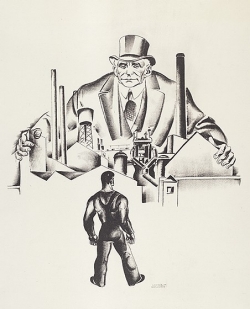
Lewis Hine, Addie Card, 12 years old. Spinner in cotton mill, North Pownal, Vermont, 1910, gelatin silver print, National Gallery of Art, Washington, Pepita Milmore Memorial Fund, 2014.164.1
Invite students to select a work of art from the image set that features people, such as Textile Merchant, “Wooding Up” on the Mississippi, or Addie Card, 12 years old. Spinner in cotton mill, North Pownal, Vermont. Encourage them to consider the multiple viewpoints or stakeholders, both seen and unseen, in the work. Next, ask them to identify a single individual and imagine that person’s point of view. Students might consider questions such as:
- What does this person gain from participating in this industry? What does this person lose?
- What does this person value or care about?
- What actions does this person engage in? How might those actions affect his or her body, mind, and emotions?
Students may use evidence that can be seen in the work of art, as well as primary and secondary sources about the industry. Ask students to contemplate the individual’s opinion of the industry. For a greater challenge, try this activity using the environment as the stakeholder.

Hugo Gellert, Primary Accumulation 3, 1933, lithograph, National Gallery of Art, Washington, Reba and Dave Williams Collection, Gift of Reba and Dave Williams, 2008.115.2026
The New Oxford American Dictionary defines capitalism as “an economic and political system in which a country’s trade and industry are controlled by private owners for profit, rather than by the state.” The United States is a capitalist country. People from a variety of fields and backgrounds argue about the pros and cons of capitalism, and whether it is a sustainable system. (For more background, see “What ‘Capitalism’ Is and How It Affects People” in Teen Vogue.)
Distribute images from this unit to your students and ask them to identify which work of art they think best illustrates capitalism and why. Then, invite them to conduct more research into arguments for and against capitalism and ask them to take a position on the system.
Industries developed across the United States in the 19th century as settlers spread across the country and claimed lands. New industries continue to emerge today. Ask students to investigate their community: What was its primary economic driver in the past? What is its leading business today? Consider what made these industries possible, such as geography, immigration or migration, climate, and education. Invite students to reflect on the benefits and downfalls of today’s industry, consulting with friends, family members, and neighbors in order to gain multiple perspectives on the local industry. Students should then create a portrait of industry in their community. They might try the following:
- Create a portrait of an industry worker
- Photograph a physical site or building
- Tell a visual or graphic story of the industry
What colors, lines, shapes, patterns, or symbols can be employed to make the works of art more meaningful? Offer examples of symbols from the image set, such as a broken tree stump (George Inness’s The Lackawanna Valley) or a spiderweb (Lamar Baker’s Walk Into My Parlor), as well as Soledad Salamé’s use of distortion to create meaning in Gulf Distortion XII.




